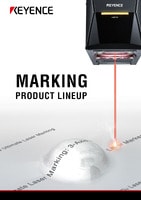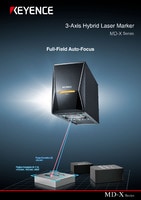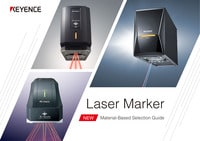Industrial Laser Marking Systems / Laser Markers
How to Choose a Fibre Laser Engraver
-
Tags:
- Laser Engraving , Semiconductor , Metal
Industrial laser markers are not something people oftentimes think of unless tasked with a marking, cutting, or welding project, though a large portion of manufactured products require them for one function or another. Whether it is a 2D code, company logo, date, or time stamp, laser marks are everywhere in nearly every industry.
With such diversity, lasers perform many functions, but not all lasers are created equal. Lasers are categorised by their oscillator—the medium that builds the light energy to produce the beam. Some oscillators utilise crystals, plasma, or liquids, but one reigns supreme in popularity: the fibre laser.
Fibre lasers are widely used across industries, with promising market growth in the next five years. In fact, the fibre laser market is predicted to increase by $8.78 billion by 2027!
The excitement is no coincidence—fibre lasers are known for high output power and speed with a wavelength of 1090 nm. This makes them the champions of engraving metals with an environmentally friendly, permanent, efficient, and contactless methodology. However, the growing market can make choosing the right fibre laser for your production an overwhelming task. In this blog, we’ll discuss what you should consider before making your fibre laser engraver purchase.
Fibre Laser Engraving Process
A fibre laser engraves by focusing a beam of light on the surface of a material and then moving in a predefined pattern. The beam heats the target until it transitions from a solid to vapor and then evaporates. The fibre laser then leaves behind a carved-out and clean design. The fibre laser engraver doesn’t leave any residue behind on the target or use consumables, so there’s no need for extra finishing or waste disposal processes.
After fibre laser engraving, the design is permanent, so you can engrave and move on. The engraved mark withstands painting, environmental conditions, shot blasting, and sandblasting.
We’re here to provide you with more details.
Reach out today!

Applications of Fibre Laser Engraving
Traceability
Every industry requires some type of traceability mark, so there is a massive scope when it comes to fibre laser engraving machines.
These traceability marks are logos, serial numbers, QR codes, or data matrix codes. Many industries—like the medical device, aerospace, and automotive industries—require permanent and high-contrast traceability marks that withstand harsh conditions or extra processing. These necessities encourage the use of a fibre laser machine.
Discover more about this product.
Click here to book your demo.

Key Considerations for Choosing a Fibre Laser Engraver
When choosing the best fibre laser engraving machine for you, there are two components to consider—your manufacturing goals and what the machine offers you beyond just engraving.
Types of Fibre Laser Engraver Machine
One of the main considerations to make when deciding which fibre laser best fits your application is how you imagine the laser integrating into your production. If you are pumping out thousands of parts per day, it may warrant integrating into an automated line. If production demands are relatively low, you may simply need a manually loaded enclosure with a laser mounted inside. Regardless of your demands, part shapes and sizes, etc., KEYENCE has a large fleet of product experts who travel directly to customer sites to provide consultative demonstrations, proof of concept, and integration assistance so that even the most challenging applications can be solved.
Additional Fibre Laser Engraving Machine Features and Software
Most fibre laser engravers include computer numerical control (CNC) and software for uploading files, but it’s crucial to consider how much more advanced you need your fibre laser engraver to be.
If you work at a plant that produces one type of part, then basic repetitive software may suffice. But if your manufacturing floor processes parts of different shapes, sizes, and materials, you’ll want to ensure that your laser software can constantly adjust in a user-friendly way.
This may mean choosing a system that can adjust to varying part geometries rather than being stuck marking in a single plane—a system that can mark on a variety of different materials and surface finishes or even something that can act as a catch-all, no matter what you throw at it.
The Advent of Hybrid Lasers
Hybrid laser technology has provided a significant leap forward in laser marking. In fact, it has taken fibre laser marking a step further when it comes to its ease of use, adaptability across a variety of materials, and overall marking capabilities. Because of this, they have been a game-changer for aerospace, electronics, medical, automotive, and other industries.
After-Sale Services
If you’re ready to make the jump into the laser engraver with your ideal beam, machine, and software, there is one more step! Laser engravers are advanced technological systems that often require specialised technicians for installation and technical support. Consider your needs for technical services.
Are you interested in a warranty? Will you need installation support? Does the company you’re planning to purchase from offer technical support? Is the support in person or over the phone? Do they have an office near you?
All of these questions are essential for your choice of buying a fibre laser engraver.
We’re here to provide you with more details.
Reach out today!

Ready for Your Perfect Choice?
Choosing a fibre laser engraver will be a breakthrough choice for your production. Whether you’re looking to engrave faster, decrease your environmental impact, stay compliant with regulations, or tackle new projects, a fibre laser machine can do it all.
Still, fibre laser engraver is a sizable undertaking, and we know you probably have questions. At KEYENCE, we like to share the wealth of knowledge. As a worldwide leader of laser marking systems with a 24/7 support team, we’re ready to help you find your best fibre laser machine.
Contact us today for a call, or if you’re a more hands-on learner, request a demo!
Discover more about this product.
Click here to book your demo.






